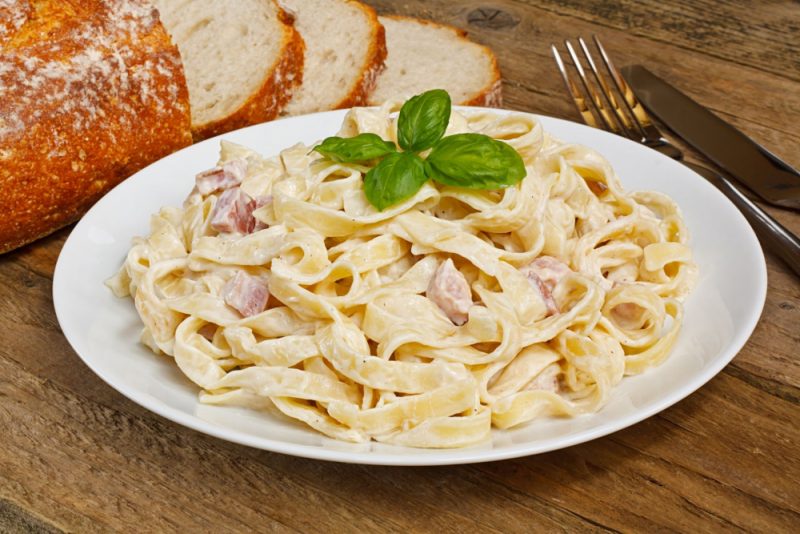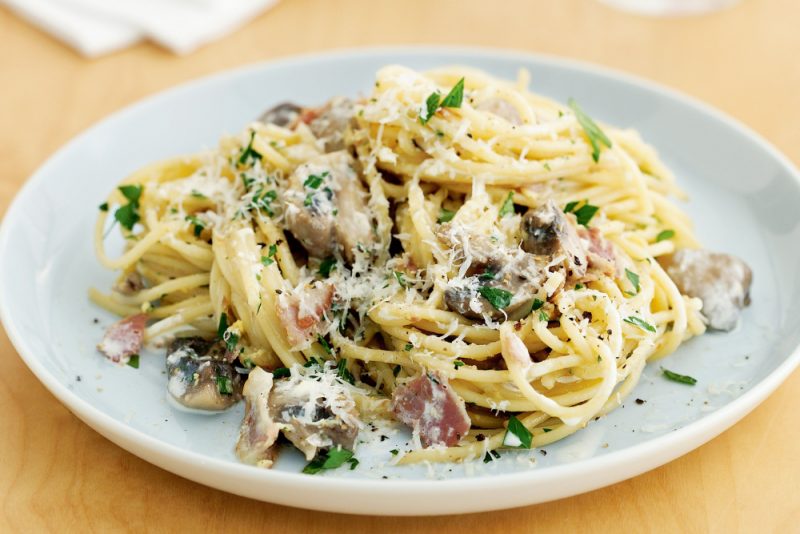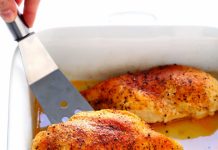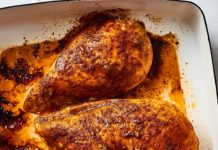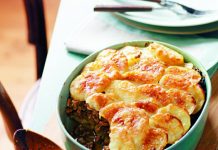Spaghetti Carbonara is one of the most common dishes in Italy. Simple, satisfying, incredibly tasty due to the thick sauce with a rich taste and aroma, carbonara paste is loved in all Italian corners, so is it any wonder that the authorship of this dish is attributed to itself in different regions of Italy? We will tell you what a real Italian pasta alla carbonara dish is, how it was born, what variations it currently has and how to cook carbonara pasta in an ordinary kitchen.
Material Content:
Carbonara pasta - classic with bacon and cream
Pasta carbonara recipe with bacon and cream is a popular and common recipe not only in Italy but also in Russia. In fact, what could be tastier than fried bacon flavored with fresh cream and cheese? But this is a real historical recipe, which was invented by the ancestors of the dish - free coal miners of Italy, who extracted carbone (it.) - charcoal, and therefore forced to spend most of their lives in the forests. They came up with food for themselves from slices of smoked bacon and brisket, pasta that had been stored for a long time and did not spoil, as well as sheep’s cheese. The meat cubes fried in the cauldron, the pasta cooked there and the grated cheese made up this simple food that has survived to our time.

So, to cook carbonara paste, we need:
- 350 g pasta;
- 2 tbsp. l cream;
- 4 eggs;
- 2 tbsp. l oils;
- a pinch of fresh black pepper and ground nutmeg;
- salt;
- a couple of cloves of garlic;
- 100 g strips of bacon;
- Parmesan cheese - optional.
Important! This is a recipe for real Italian pasta, so to preserve its authenticity, only olive oil and durum wheat pasta are taken. Be sure to remember the nutmeg.We are used to using parmesan, it is given below, but the Italians are preparing carbonara with Pecorino cheese.
Getting started:
- Pour water into the pan, salt and cook pasta according to all the rules.
- While they are boiling, fry the garlic in a pan in a non-stick coating on a tablespoon of oil.
- Add diced bacon to it.
- Fry it for no more than a couple of minutes so that the pieces do not have time to harden.
- Shake separately in a bowl, spices, add cream and mix. Set aside for now. Tip: For those who love spaghetti sauce, you can increase the amount of cream.
- Drain the pasta, place the pasta in a pan with bacon and garlic and warm it all together.
- Pour the mixture of eggs and cream on top and mix quickly. Warm a little more until the pasta and sauce are completely combined and until the eggs begin to thicken a little, but do not curl from hot pasta.
- On pasta, if desired, rub the parmesan cheese.
Replace the bacon with ham
Bacon can be replaced partially or completely with ham. It will also turn out very well, especially if you do not skimp on cream.
You will need:
- half a liter of 10 percent cream;
- 500 g of pasta;
- 300 g of cheese (parmesan or sheep);
- 300 g ham;
- 200 g of bacon (or the same volume of ham);
- to taste salt, pepper, other spices;
- 3 eggs;
- a spoonful of olive oil.
Your actions:
- Boil pasta in salted water - feathers, “spirals”, spaghetti. You don’t have to cook the pasta until it’s ready — it should be a little firm — as the Italians say, al dente.
- In the meantime, pour a little olive oil into a heated frying pan and fry the ham and bacon cut into strips or cubes.
- Beat a little salt with eggs and seasonings, but not to splendor, but to make it evenly, add cream. Grate the cheese and put in the mixture half. Mix.
- Fold pasta and quickly put in a pan with meat products. Stir, pour in the mixed cream with eggs. Mix everything carefully again so that the sauce covers the whole pasta.
- Put in portioned plates, sprinkled with the second half of cheese. Arugula leaves go well together.
Spaghetti carbonara with chicken
In this recipe, chicken fillet (200 g) is soloed, it replaces bacon and obliges you to use garlic in cooking.
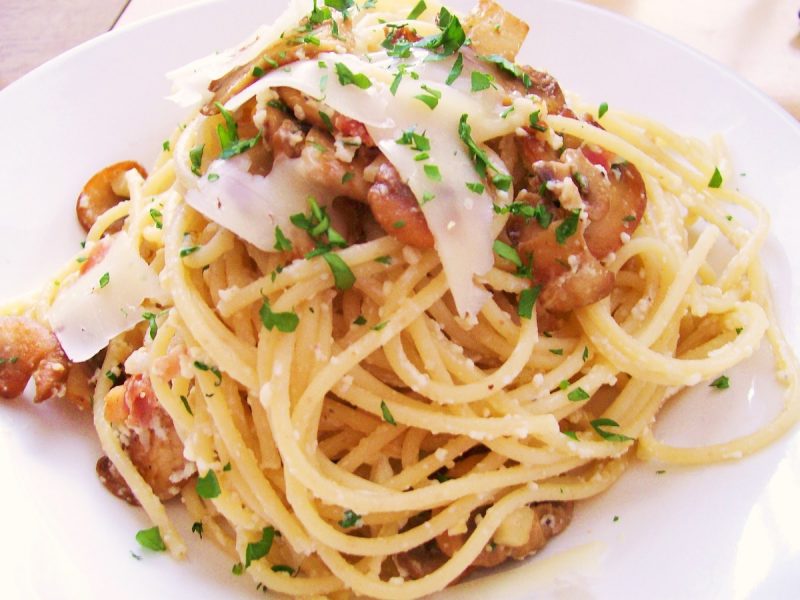
For 300 g of pasta you need:
- half a glass of cream;
- 3 eggs;
- a couple of cloves of garlic;
- 3 tbsp. l olive oil;
- 50 g of parmesan or other hard cheese;
- salt, ground pepper, basil.
Cooking like this:
- Fry small pieces of fillet in oil until tender.
- Pour finely chopped garlic into the pan, fry for a couple of minutes.
- Add salt and cream, without adding heat, so that the cream does not curl.
- Boil the pasta separately, adding salt and a little vegetable oil to the water.
- For the sauce, beat the beaten eggs, pepper, add the grated cheese and basil.
- We discard the finished pasta, put it in a pan, heat it and fill it with egg-cream mixture.
- Warming up for several minutes on the smallest fire, serve hot, sprinkled with ground pepper.
We supplement the recipe with mushrooms
If there are few champignons in the house, you can enrich the recipe for making carbonara with bacon. To do this, take 200 g of spaghetti pasta, mushrooms, cream, a couple of eggs, 100 cheese and bacon, a little pepper and salt and a couple of spoons of vegetable oil.
- Boil the pasta.
- Fry mushrooms and meat products lightly in oil.
- Beat the egg-cream mixture, seasoning it with cheese and spices and warm, without bringing the eggs to coagulation.
- Combine everything with pasta.
- When serving, sprinkle with small cheese chips.
Read also:carbonara - a classic recipe
Sauce options

- Italians often add dry white wine instead of cream, this makes the sauce even more piquant. To preserve the creamy taste, you can pour a little milk for lack of cream.
- Another version of the sauce was offered by the famous culinary specialist Jamie Oliver.He insists that instead of bacon, a dried pork cheek is used, which is low in meat and high in fat. This fat should be siphoned off by placing small pieces of fat on a cold frying pan. So it will sink faster. Next, a large clove of crushed garlic is added to the roast at the same time (he will give up his aroma and will need to be removed later). Enrich the taste with freshly ground pepper. And now the main thing in this sauce: no cream! The fire is extinguished under the pan, and we add the pasta to it along with the rest of the water in which they were cooked. This is important - fat and water become an emulsion! Eggs whipped with cheese and salt are added to it and mixed again with pasta. If necessary, add some more water from pasta and warm up, avoiding the folding of yolks. It turns out a delicious sauce, which is in no way inferior to creamy!


